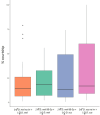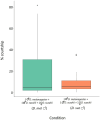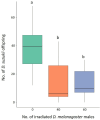Developing heterospecific sterile insect technique for pest control: insights from the spotted wing fly Drosophila suzukii
- PMID: 40331331
- PMCID: PMC12332116
- DOI: 10.1002/ps.8875
Developing heterospecific sterile insect technique for pest control: insights from the spotted wing fly Drosophila suzukii
Abstract
Background: Reproductive interference (i.e. sexual interaction between males of one species and females of another species that reduce the fitness of one or both the interacting individuals) is an important species interaction significantly affecting population dynamics and persistence. However, its exploitation in pest control remains overlooked. Here, we investigated the possible integration of reproductive interference into the sterile insect technique (SIT) to develop a heterospecific SIT (h-SIT). Under this approach, contrary to the classic SIT, sterile heterospecific males from closely related, nonpest species are released to compete with the pest population for mates. To this end, we focused on the invasive pest species Drosophila suzukii and used D. melanogaster as the control species. First, we investigated the effect of irradiation on D. melanogaster sterility and longevity. Then, we tested the mating performance of irradiated males and their ability to reduce the D. suzukii fitness.
Results: We found by microcosm experiments that: (i) irradiation induced high levels of D. melanogaster male sterility without reducing longevity; (ii) irradiated D. melanogaster males court D. suzukii females as much as D. suzukii males do, and they couple, mate with and inseminate heterospecific females; (iii) irradiated D. melanogaster males significantly reduce the offspring of D. suzukii females under two different species ratios.
Conclusion: Our results provide the first foundations for the development of a h-SIT against D. suzukii, an approach which can be tested against other groups of pest species. © 2025 The Author(s). Pest Management Science published by John Wiley & Sons Ltd on behalf of Society of Chemical Industry.
Keywords: Drosophila melanogaster; Drosophila suzukii; pest control; reproductive interference; sterile insect technique.
© 2025 The Author(s). Pest Management Science published by John Wiley & Sons Ltd on behalf of Society of Chemical Industry.
Conflict of interest statement
The authors declare no conflicts of interest.
Figures






Similar articles
-
Optimizing irradiation dose for Drosophila melanogaster males to enhance heterospecific Sterile Insect Technique (h-SIT) against Drosophila suzukii.PLoS One. 2025 Jul 3;20(7):e0320546. doi: 10.1371/journal.pone.0320546. eCollection 2025. PLoS One. 2025. PMID: 40608745 Free PMC article.
-
Dissecting the sterility phenotype in gene edited Drosophila suzukii pgSIT males.Sci Rep. 2025 Jan 31;15(1):3903. doi: 10.1038/s41598-025-88598-w. Sci Rep. 2025. PMID: 39890940 Free PMC article.
-
Evaluating the biological quality of mass-reared Anopheles arabiensis males irradiated as pupae or as adults.Malar J. 2025 Jul 1;24(1):212. doi: 10.1186/s12936-025-05455-x. Malar J. 2025. PMID: 40598502 Free PMC article.
-
The Potential of Plant-Based Biorational Products for the Drosophila suzukii Control: Current Status, Opportunities, and Limitations.Neotrop Entomol. 2024 Apr;53(2):236-243. doi: 10.1007/s13744-023-01119-0. Epub 2023 Dec 22. Neotrop Entomol. 2024. PMID: 38133734
-
Gonadotropin-releasing hormone (GnRH) analogues for premenstrual syndrome (PMS).Cochrane Database Syst Rev. 2025 Jun 10;6(6):CD011330. doi: 10.1002/14651858.CD011330.pub2. Cochrane Database Syst Rev. 2025. PMID: 40492482 Review.
Cited by
-
Optimizing irradiation dose for Drosophila melanogaster males to enhance heterospecific Sterile Insect Technique (h-SIT) against Drosophila suzukii.PLoS One. 2025 Jul 3;20(7):e0320546. doi: 10.1371/journal.pone.0320546. eCollection 2025. PLoS One. 2025. PMID: 40608745 Free PMC article.
References
-
- Cain ML, Bowman WD and Hacker SD, Ecology, 2nd edn. Oxford University Press, Incorporate, Oxford, p. 648 (2011).
-
- Hoddle MS and Van Driesche RG, Biological control of insect pests, in Encyclopedia of Insects. Academic Press, Cambridge MA, pp. 91–101 (2009).
-
- Gröning J and Hochkirch A, Reproductive interference between animal species. Q Rev Biol 83:257–282 (2008). - PubMed
-
- Kishi S, Nishida T and Tsubaki Y, Reproductive interference determines persistence and exclusion in species interactions: sexual interference governs competition. J Anim Ecol 78:1043–1049 (2009). - PubMed
-
- Kyogoku D, Reproductive interference: ecological and evolutionary consequences of interspecific promiscuity. Popul Ecol 57:253–260 (2015).
MeSH terms
Grants and funding
LinkOut - more resources
Full Text Sources

